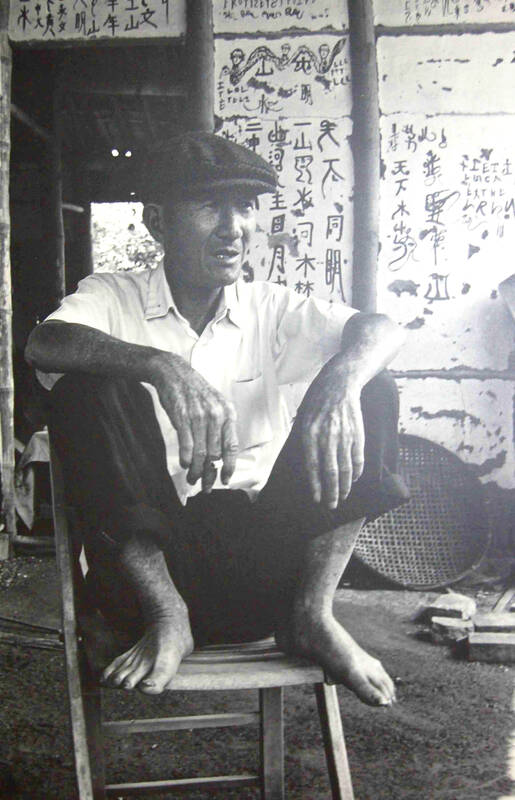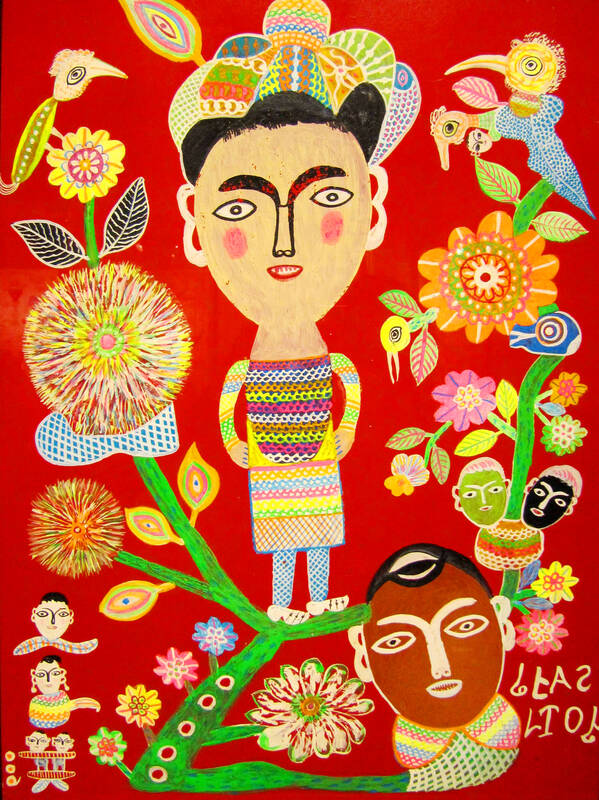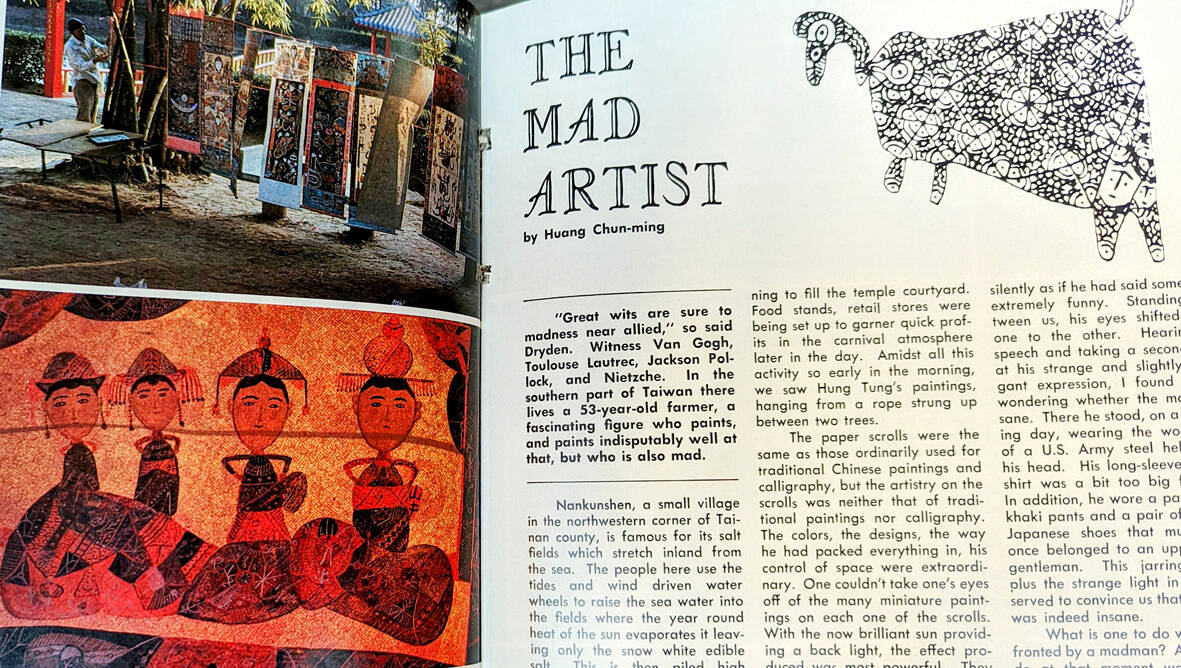Feb. 20 to Feb. 26
Just a few years removed from the peak of his fame, Hung Tung (洪通) lived alone in a dilapidated house in rural Tainan in the 1980s, working on his art and subsisting mostly on sweet soymilk. His family had moved to Tainan City, but he refused to join them.
Neighbors were mostly used to this peculiar old man, who seemed to live in his own world and rarely interacted with others. Even though he barely had enough to eat, he still refused to sell his paintings. Several months after the death of his wife, Hung passed away on Feb. 23, 1987.

Photo courtesy of Hung Shih-pao
At his posthumous retrospective, his paintings sold for as little as NT$30,000 — quite meager for an artist who was once the talk of the nation. Art collector Chou Yu (周渝) urged Hung’s son to stop selling the paintings, telling him that they would fetch much higher prices in the future.
Chou was right. A second “Hung Tung craze” swept the art world in the 1990s, with one piece fetching NT$3.6 million in 1996. On the ninth anniversary of his death, Hung’s paintings were exhibited overseas for the first time -- first in New York City, then at the Asian Arts & Cultural Center at Towson University in Maryland.
Ever averse to publicity, Hung probably wouldn’t have liked it if he were alive.

Photo: Hsi Yen-hsia, Taipei Times
MIDLIFE CRISIS?
Nicknamed the “Amateur Painter” and “Mad Artist,” Hung was born in 1920 in Kunchiang Village (鯤江) in rural Tainan. It was a barren area, and the illiterate Hung scraped out a living as a fisherman, bricklayer, fishmonger, candle vendor, construction worker and spirit medium.
Soon after he turned 50, Hung’s wife suddenly found him kneeling in front of her, begging her to let him stop working and focus on painting. She declined twice, but finally relented. He clearly remembers that day: it was Nov. 4, 1969.

Photo: Han Cheung, Taipei Times
“My life has been filled with more hardships than happiness,” Hung tells writer Chang Yin (常茵) in an interview. “After I turned 50, I started to experience suffocating feelings of despondence that made me feel sad and mournful. I needed to get that feeling off my chest, so I picked up a stone and started drawing on the ground and the walls. I was engrossed and soon got the hang of it.”
“Drawing was the only way for me to forget the poverty and suffering of everyday life. It made me happy on a spiritual level,” he adds.
Hung locked himself in his room, painting day and night. The villagers looked down on his behavior, convinced that he had gone nuts. His cousins called him a “useless person” to his face, while others said that he was possessed by an evil spirit.
When he did venture out, it was often to see exhibits and to learn from professional artists. Tseng Pei-yao’s (曾培堯) recalls in a Lion Art Monthly (雄獅美術) article seeing a depressed-looking old man from the countryside at his doorstep one day. He had a large roll of drawings that he claimed were made by his farmer friend, and wanted Tseng’s opinion on them.
“When I told him my thoughts, he seemed happy, and said that I was the first person to praise these works. He said others told him they were worthless and worse than a child’s scribblings,” Tseng writes.
Hung insisted that Tseng become his teacher. Between 1971 and 1973, Tseng gave Hung suggestions on material and subject matter, but claims to not have influenced his style.
DISCOVERY OF A MADMAN
In May 1972, the Wangye temple in nearby Nankunshen (南鯤鯓) held a photography contest. Hung put up about 20 of his pieces near the temple, which caught the attention of an Echo of Things Chinese (漢聲) magazine team who was there to cover the deity’s birthday ceremony.
The English-language magazine published “The Mad Artist” in its July-August edition, describing Hung as a “fascinating figure who paints, and paints indisputably well at that, but who is also mad.”
“The colors, the designs, the way he had packed everything in, his control of space were extraordinary,” author Huang Chun-ming (黃春明) writes. “One couldn’t take one’s eyes off the miniature paintings on each one of the scrolls ... Small figures seemed to be winking at me, beckoning me to come closer, the flowers and shrubs even seemed to exude a sweet fragrance …”
Huang then spoke to Hung, who seemed surprised that they liked the art. Switching between “shy, humble” and “arrogant, self-satisfied” personas, the writer was convinced that Hung was a crazy genius. He found it hard to believe that Huang had never lived outside the village and had only been painting for three years.
The interview ended with Hung accusing them of stealing his paintings and threatening them with martial arts and black magic. They offered to buy some of the work, but Hung refused to sell.
News of the Mad Artist spread, leading to the craze known as the Hung Tung Phenomenon (洪通現象).
The frenzy reached a climax in 1976, when Hung had his first solo show at the US Information Agency office in Taipei. China Times (中國時報) devoted two-thirds of a page to him for six days in a row, leading other media to follow suit. Tens of thousands of visitors packed the venue for the entire two weeks of the exhibition.
However, Hung remained adamant on not selling his paintings and remained destitute. After three exhibitions in one year, he grew tired of the attention and returned home, becoming a recluse.
‘HUNG TUNG PHENOMENON’
Chen Chi-hsiung (陳吉雄) examines Hung’s meteoric rise and fall in Study on the Hung Tung Phenomenon (洪通現象之研究).
According to Chen, Hung’s rise coincided with the “nativist movement” (鄉土運動) in Taiwan, which began in the late 1960s as a pushback against the Western, modernist style that dominated the cultural scene. This sentiment for local culture and identity only grew in the 1970s as the nation suffered setback after setback in the international arena.
“These events sparked a strong sense of crisis and self-awareness among Taiwanese society and the cultural community as they pondered Taiwan’s fate,” Chen writes.
This period saw the rise of Taiwan-born realist writers, as well as ventures by Western-educated musicians to rural areas to “discover” traditional folk music. The fine arts world, however, was still lacking in nativist content by the early 1970s, and Hung’s humble background and reputation as an untrained genius was the perfect embodiment of the sentiment.
“His success was a product of the times,” Chen writes. “Due to the [media frenzy], viewing his art became a trendy thing to do for the masses … as popular culture is often disposable and ephemeral, it’s not hard to understand why Hung Tung’s stardom rose as quickly as it fell.”
Chen adds that most people saw Hung as some sort of fairy-tale figure with a fascinating backstory instead of purely as an artist. They visited his exhibit out of curiosity as if it were a spectacle, and as such, his art was quickly forgotten until it was “rediscovered” a decade later.
Taiwan in Time, a column about Taiwan’s history that is published every Sunday, spotlights important or interesting events around the nation that either have anniversaries this week or are tied to current events.

Most heroes are remembered for the battles they fought. Taiwan’s Black Bat Squadron is remembered for flying into Chinese airspace 838 times between 1953 and 1967, and for the 148 men whose sacrifice bought the intelligence that kept Taiwan secure. Two-thirds of the squadron died carrying out missions most people wouldn’t learn about for another 40 years. The squadron lost 15 aircraft and 148 crew members over those 14 years, making it the deadliest unit in Taiwan’s military history by casualty rate. They flew at night, often at low altitudes, straight into some of the most heavily defended airspace in Asia.

This month the government ordered a one-year block of Xiaohongshu (小紅書) or Rednote, a Chinese social media platform with more than 3 million users in Taiwan. The government pointed to widespread fraud activity on the platform, along with cybersecurity failures. Officials said that they had reached out to the company and asked it to change. However, they received no response. The pro-China parties, the Chinese Nationalist Party (KMT) and Taiwan People’s Party (TPP), immediately swung into action, denouncing the ban as an attack on free speech. This “free speech” claim was then echoed by the People’s Republic of China (PRC),

Many people in Taiwan first learned about universal basic income (UBI) — the idea that the government should provide regular, no-strings-attached payments to each citizen — in 2019. While seeking the Democratic nomination for the 2020 US presidential election, Andrew Yang, a politician of Taiwanese descent, said that, if elected, he’d institute a UBI of US$1,000 per month to “get the economic boot off of people’s throats, allowing them to lift their heads up, breathe, and get excited for the future.” His campaign petered out, but the concept of UBI hasn’t gone away. Throughout the industrialized world, there are fears that

Like much in the world today, theater has experienced major disruptions over the six years since COVID-19. The pandemic, the war in Ukraine and social media have created a new normal of geopolitical and information uncertainty, and the performing arts are not immune to these effects. “Ten years ago people wanted to come to the theater to engage with important issues, but now the Internet allows them to engage with those issues powerfully and immediately,” said Faith Tan, programming director of the Esplanade in Singapore, speaking last week in Japan. “One reaction to unpredictability has been a renewed emphasis on